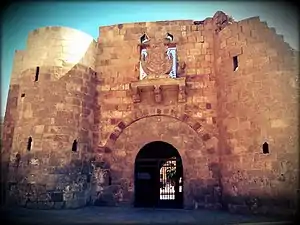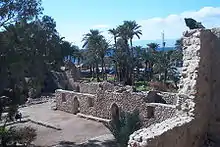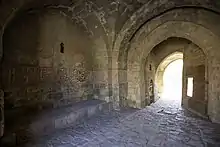Aqaba Fortress
The Aqaba Castle, Mamluk Castle or Aqaba Fort (Arabic: قلعة العقبة, romanized: Qalʿat al-ʿAqaba), located in Aqaba, Jordan, is a fortress originally built by Crusaders in the 12th century, and named Helim. Ayla (ancient Aqaba) was recaptured by Saladin in 1187 and the fortress was destroyed, until it was rebuilt in the early 16th century under the Mamluk Sultan Al-Ashraf Qansuh Al-Ghuri.
In July 1916, the fortress was the location to a victory of the Arab Revolt, when this heavily defended Turkish stronghold fell to an Arab camel charge. Lawrence of Arabia rode triumphantly from here to Cairo to report the good news to General Allenby. The port of Aqaba became a major supply base for the advancing Arab Revolt.[1]


The fort is located next to the Aqaba Flagpole, which carries the flag of the Arab revolt against the Ottomans. Adjacent to the fort is the Aqaba Archaeological Museum, which was once the Sharif Hussein's residence.
History
The castle was originally built as a Crusader castle, and was largely rebuilt in the 14th Century B.C.E. by the Mamluks, specifically in 1587 B.C.E. during the reign of the final Mamluk sultan. Many times after this, the fortress was built over. In the beginning of the 16th Century,
References
- "PBS - Laurence of Arabia - Arab revolt". PBS. Retrieved 10 January 2012.
External links
- https://www.pbs.org/lawrenceofarabia/resources/locations5.html
- http://www.kinghussein.gov.jo/tourism6e.html#Aqaba
Gallery
 Interior of the Aqaba Fortress
Interior of the Aqaba Fortress Entrance to the Aqaba Fortress
Entrance to the Aqaba Fortress View of fort
View of fort Fort
Fort

